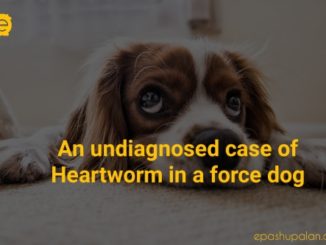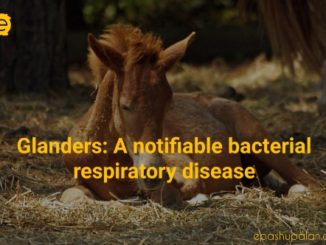Bovine lameness is an increasing concern as it affects the health, productivity, and welfare of dairy cattle to a great extent. It is 3rd most prevalent disease after mastitis and infertility in the dairy industry today and is an important welfare issue that significantly impacts dairy economics by lower fertility and leading to involuntary culling of lactating dairy cattle. The incidence of lameness has gradually increased over the past 20 years, probably due to changes in management, increased production, and genetic disturbances. Lameness in cattle is not a disease entity rather it is a clinical syndrome of different diseases. Both non-infectious lesions such as heel erosions, white line disease, sole ulcers, sole hemorrhages, underrun soles, sole avulsions, and interdigital hyperplasia and infectious claw lesions such as digital dermatitis, interdigital dermatitis, and foot rot have been identified in cows. The etiology and pathogenesis of many of these diseases remain poorly understood. There could lie individual factors like stage of lactation, parity, weight, genetics, and/or herd factors, like housing, environment, management, and nutrition which affect the prevalence of lameness. This article briefs about various management factors that can affect the incidence of lameness in cows.
1. Effect of housing
A zero grazing system is adapted in many parts of the world to adjust the feed intake of cows according to their production. But nowadays, there is an increasing ethical demand for cows to have access to pasture, as this permits cows to exhibit natural behavior, which improves the health and welfare of animals and there is a perception that grazing animals are less affected by lameness. But grazing can also have harmful consequences by making it more difficult for animals to get up and lay down especially in wet slippery grounds which in turn can increase chances of lameness due to ligament injuries.
The major risk factor of the zero-grazing system is the standing time. In pasture-based dairy systems, cows stand for the same time or even longer than housed cattle to fulfill their nutrient demands as the grass has lower nutrient content than total mixed ration (TMR). But the major difference is that stall-fed animals are kept on the concrete floor which has a detrimental effect on claw horn but grazing animals stand and roam on pastures, which is much more comfortable. Nevertheless, concrete flooring in holding areas and milking parlor as well as unhygienic conditions there, are considered risk factors for lameness in grazing systems. The designs of the ground or floor surface affect the wear rate and showed a higher rate of horn growth in containment housing than pasture-raised cows with around 35 percent more wear on concrete floors.
2. Effect of flooring
The floor type is one of the most important aspects of the loose housing system due to the effects it has on locomotion. In cattle houses, most walkways, milking parlor, and feeding areas are concrete floored as it has reasonable hygienic features and is fairly durable, cheap and wear-resistant, however, is not an ideal surface for cows to walk and stand on, particularly when covered with manure slurry as the foot of dairy cows was not built for long-standing on concrete floors. Less desired features of concrete floors are hardness, abrasiveness, and slipperiness which contribute to foot lesions and lameness and it has been demonstrated as a risk factor for the development of sole hemorrhages. But as the size of the herd continues to grow, so must the surface area of concrete, otherwise earthen floors will become a mixture of manure, urine, and moisture-ridden mud. In intensive housing systems, cows spend most of their time on concrete and these systems are associated with restraint or confinement that inhibits locomotor activity.
The natural walking behavior of the cow is not possible on concrete floors due to insufficient friction. The critical coefficient of friction for slippage by the cow has been suggested to be 0.4 when a cow starts to walk from a standing start but most concrete floors have an average friction coefficient of about 0.35, which is lower than what is needed for normal movement by the cow.
The use of rubber floors can help to stop the overwearing of the claw but placing rubber flooring in the feeding area does not increase the time spent for feed intake, but significantly increase the time spent standing in the feed area and reduce the time spent in the lying stalls. Therefore, the potential benefits of the additional cushioning and improved footing provided by rubber floors are likely neutralized by additional standing time and claw over-growth.
3. Effect of Environment
Environmental risk factors for lameness in cattle include seasonal conditions, claw trimming frequency, cow track maintenance, and improper handling of livestock. Seasonal pattern of lameness depending upon rainfall and in some locations, heat stress is observed. Heavy rainfall in some regions, accompanies higher incidences of lameness as wet conditions increase the moisture content of the claw horn, which predisposes to softer claw horn, increased wear rates, and lesions of the claw due to extreme sole thinning. Thin soles leading to separation of sole from the white line in the abaxial toe region and is a major problem in housed dairy cattle. These lesions are likely to have severe consequences resulting in toe abscesses that may become chronic problems in affected animals. The constant exposure to moisture on the feet can make the surrounding skin more susceptible to irritation, infection, and lesions, all stimulating factors to an early onset of lameness.
On the other hand, heat stress leads to significant lameness issues in areas affected by periods of hot and humid or hot and dry weather conditions. Higher levels of lameness appear to correspond with times of extremely hot weather and/or follow them. Lameness associated with heat appears to peak during the months of late summer and early fall (July through October). Rumen acidosis from decreased salivary buffering and respiratory alkalosis from elevated respiratory rates are predisposed to heat stress. During such times, the reduction of heat stress is crucial to the success and health of milk cattle.
The impact of environmental factors on the hoof’s health was very high and because of the low heritability of hoof diseases, improving their health in the short term could be achieved most easily by improving the environmental factors.
4. Effect of Nutrition and lameness
The correct nutrition of the dairy cow is vital to the health of the hoof and is important for the development of tough, durable claw horns that can withstand environmental challenges. In modernized rations, high soluble carbohydrates and reduced effective fiber also cause a significantly higher rate of rumen acidosis and laminitis.
Cows fed a higher concentrate diet had 3.66 times more lameness incidences per week and the degree and span of lameness events were markedly higher than cows that were fed a lower concentrate diet. Major lesions were solar lesions in the hind feet. The higher the concentrate-to-forage ratio, the higher the daily metabolizable energy intake, or the higher the daily crude protein intake may have been the predisposing causes of the higher incidence. Further, there is the ruminal conversion of the amino acid histidine to histamine by decarboxylation of the amino acid at low pH (found in ruminal acidosis) by the bacteria Allisonella histaminiformans, which further aggravates the pathogenesis of laminitis.
The protective characteristics of the digital cushion in the hoof may depend on the composition of fatty acids that may be affected by the diet. Improving the defensive role of the pads could then be used as a further method to reduce the lameness of the claw horn.
The supply of trace minerals also affects claw integrity. Minerals play an important role in maintaining excellent claw quality. Along with Ca, P, and Mg, trace minerals like Cu, Zn, Co, Mn, I, and to some extent selenium play a crucial role in minimizing lameness through their role in the production of horn tissue and maintenance of epithelial and connective tissue. Trace minerals such as Zn, Mn, Cu, and Co have an important roles in protein synthesis, vitamin metabolism, formation of connective tissue and immunity function.
The insufficient supply to the corium of sulfur-containing the amino acids methionine and cysteine also increases the incidence of lameness as a result of soft horn formation. In cows affected by laminitis, a reduction in the proportion of cysteine and methionine occurs in the claw horn. To boost the purity of hoof keratin, the use of methionine supplements has been advocated.
5. Effect of calving
The time around calving is critical in the origination of claw lesions. Claw lesions develop in heifers around parturition inducing marked lameness due to series of events associated with calving and the onset of lactation.
Sole ulcers and white line diseases occur more in first calving heifers than cows that have completed two or three lactations as primiparous cows have a thinner digital cushion than multiparous cows. The mid-fat pad typically terminates only at the apical end of the distal phalanx flexor process, resulting in a lower effect of shock absorption under the distal phalanx and increasing the risk of ulcers. Differences were observed with age in the consistency and composition of the digital cushion, with cows having considerably higher lipid content in the pads than heifers.
Internal forces acting between the third phalanx and the interior of the sole increased during the periparturient period due to systemic changes which compromise the integrity of the suspensory apparatus supporting the third phalanx within the hoof.
Relaxin, a hormone that relaxes the pelvic muscles, tendons and ligaments at the time of calving, has been thought to have a similar impact on the P3 suspension device its risk of ‘sinking’ within the claw are increased. This will lead to compression and damage of horn beneath distal phalanx and compromise the integrity of horn thus increasing the risk of sole ulcer and white line lesion.






Be the first to comment